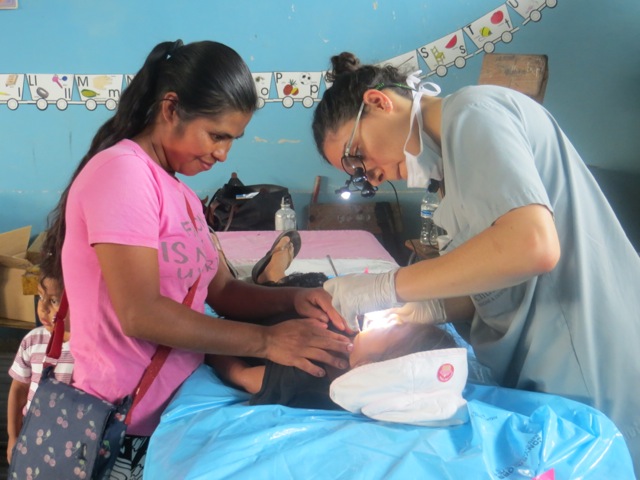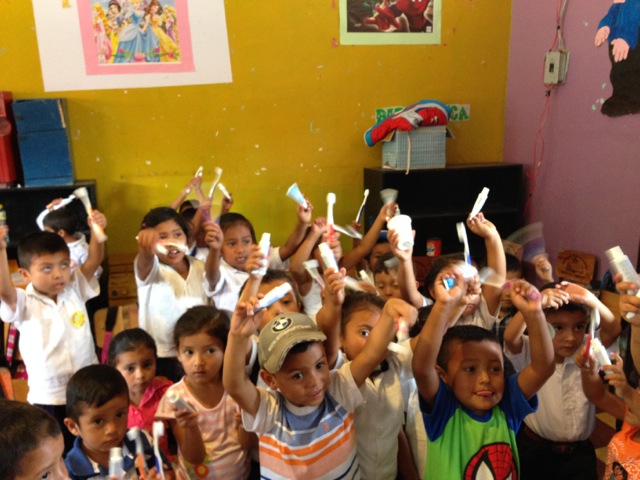My friend, Dr. Clive Friedman, forwarded this article and I feel compelled to share it with all of you as there is an important message in these lines. Please read what Jessica Gold & Anna Urbano wrote about their experience in rural Honduras.
For a week this past March we were fortunate to participate in an outreach mission to Honduras. The mission was lead by pediatrician Dr. F. Gorodzinsky and pediatric dentist Dr. C. Friedman, and included pediatric residents, registered nurses and pediatric dentists; this was the first time in fifteen years that dental students participated. This has been the most eye-opening experience of our careers as dental students thus far.
Before embarking on our daily brigades where we provided urgent dental care, we had the opportunity to meet with the public health dental team in Gracias to develop a risk management program intended to improve oral health in school-aged children. The day began by engaging the local team in a dialogue in order to assess the needs of the community, the current state of oral health, and perceived barriers to care. The Honduran dentists identified the relationship between oral health and general health with an emphasis on oral infection and general infection being a common theme. The main barriers to care: access and resources. Once these were identified, together we prioritized the issues and set specific goals that are measurable, attainable, realistic and timely for this community (“SMART”).
Together with the local oral health team, we created a pilot program whereby supervised tooth brushing will be implemented in primary schools. The “PUFA” oral health evaluative system, which identifies infection, was introduced to the public health team and was accepted with enthusiasm to help determine baseline and outcome impacts of any intervention.
U- ulceration
F- fistula
A- abscess
This system is best used in countries where decay rates are extremely high (90-99%). In such situations, assigning DMFT values alone would not be appropriate and a more advanced description of the stage of infection is needed. DMFT in this population would be in the region of 20/20 teeth for 90% of the population.
Research shows that supervised toothbrushing programs are one of the most effective ways to reduce caries rates. In high risk areas, such as rural Honduras, resources are scarce and a toothbrushing program can be a cost-effective way to reduce infection. For this reason, we decided, with the local dentists, to initiate a study in hopes of demonstrating how supervised toothbrushing can help reduce the prevalence of infection.
Following this initial meeting, we worked with the local dental team to hone their evaluation skills using the PUFA system. We visited a school in the district of Guanteque where each dentist scored the same children to ensure inter-rater reliability for the study. After these baseline PUFA scores were collected, we reviewed tooth brushing techniques with the school teacher to ensure that the toothbrushing program would be properly supervised. For some of these children, access to toothbrushes and toothpaste is scarce. It was very rewarding to see such excitement in these children as they showed off their brushing skills!
This pilot program will involve seven members of the public dental team who will be working in different communities. Each will be responsible for collecting data for the schools in their district to give a representative sample of rural Honduras. We have committed to supply the materials needed to drive this program for two years. The mayor of Gracias, who is also a dentist, was an enthusiastic supporter of developing this pilot project and promoting Gracias as a model for affecting cost effective sustainable interventions to improve overall health. In two years time, PUFA scores will be taken again and compared to the baseline scores. This will provide an information base to facilitate the design of prevention programs.
With the seeds of the study planted, the remainder of our trip was spent on daily pediatric brigades to under-serviced communities. News of our brigades quickly spread to surrounding villages, and there were people who walked for miles to visit the dentist. Every day we transformed a classroom into a mobile dental clinic. Children flooded into the room where they were first triaged and then directed to the proper area for care.  Treatment included fluoride varnish, disinfection with iodine and silver nitrate, atraumatic restorative treatment (ART) and multiple extractions. All the children received toothbrushes, toothpaste, and instructions on proper toothbrushing technique. It was heartbreaking to see such an extent of infection and the impact it has on the children’s quality of life. Most children were malnourished and showed signs of failure to thrive, due in large part to their chronic dental pain. The question for us was not “are you in pain?”, but rather “which tooth hurts the most?” Although we were able to provide some pain relief, there is still much more work to be done.
Treatment included fluoride varnish, disinfection with iodine and silver nitrate, atraumatic restorative treatment (ART) and multiple extractions. All the children received toothbrushes, toothpaste, and instructions on proper toothbrushing technique. It was heartbreaking to see such an extent of infection and the impact it has on the children’s quality of life. Most children were malnourished and showed signs of failure to thrive, due in large part to their chronic dental pain. The question for us was not “are you in pain?”, but rather “which tooth hurts the most?” Although we were able to provide some pain relief, there is still much more work to be done.
This experience was enlightening in that it reinforced the idea that we as dentists should not be merely filling a hole or extracting a tooth, but rather managing a dynamic disease process. We are fortunate to have witnessed this at such an early stage in our dental careers. This has triggered a shift in us from focusing primarily on restorative care to prevention and health promotion, and taught us to see not only the tooth in question but more broadly the individual as a whole.
by Jessica Gold & Anna Urbano
Pressed with permission for the authors

